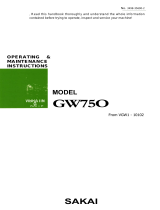
0-8 wc_bo5100026248_04TOC.fm
5.21 Creep Speed Ground Drive Control (Optional) ...................................................................................... 86
5.22 Ground Drive and Loader Controls ........................................................................................................ 87
5.23 Float Controls ........................................................................................................................................ 96
5.24 Auxiliary and High Flow Hydraulics ....................................................................................................... 97
5.25 Auxiliary Electric Controls ...................................................................................................................... 99
6 Operation
6.1 Operation Checklists ............................................................................................................................ 102
6.2 Break-In Period .................................................................................................................................... 103
6.3 Recommended Fuels—Diesel and Biodiesel ......................................................................................103
6.4 Refueling the Machine ......................................................................................................................... 104
6.5 Lift Arm Support Device ....................................................................................................................... 105
6.6 Lift Arm Manual Override ..................................................................................................................... 107
6.7 Tilting the Cab ...................................................................................................................................... 108
6.8 Lowering the Cab ................................................................................................................................. 110
6.9 Risk of Injury or Death ......................................................................................................................... 111
6.10 Entering and Exiting the Cab ............................................................................................................... 113
6.11 Emergency Exits .................................................................................................................................. 115
6.12 Operator’s Seat Adjustments ............................................................................................................... 116
6.13 Fasten Seat Belt .................................................................................................................................. 119
6.14 Starting and Stopping the Engine ........................................................................................................ 120
6.15 Operating the Machine in Extreme Weather Temperatures ................................................................ 124
6.16 Using the Engine Throttle .................................................................................................................... 126
6.17 Auxiliary Hydraulic Connections .......................................................................................................... 126
6.18 Coupler for Attachments ...................................................................................................................... 129
6.19 Using the Manual Coupler ................................................................................................................... 129
6.20 Using the Power Coupler ..................................................................................................................... 132
6.21 Testing the Attachment System ........................................................................................................... 135
6.22 Using the Brakes ................................................................................................................................. 136
6.23 Using the Windshield Wiper and Washer (Optional) ...........................................................................137
6.24 Operating the Windows ....................................................................................................................... 137
6.25 Dome Light .......................................................................................................................................... 138
6.26 HVAC Vents ......................................................................................................................................... 139
6.27 Road Travel ......................................................................................................................................... 140
6.28 Operating on Slopes ............................................................................................................................ 141
6.29 Parking the Machine ............................................................................................................................ 142
6.30 Using the Backup Alarm ...................................................................................................................... 143
6.31 Digging Below Grade ........................................................................................................................... 143
6.32 Filling and Dumping the Bucket ........................................................................................................... 144
6.33 Leveling the Ground Using the Bucket Float ....................................................................................... 145
7 Maintenance
7.1 Maintenance Overview ........................................................................................................................ 147
7.2 Lubrication Plan ................................................................................................................................... 152
7.3 Engine Oil Viscosity ............................................................................................................................. 153
7.4 Priming the Fuel System ...................................................................................................................... 154
7.5 Checking the Engine Oil ...................................................................................................................... 154
7.6 Changing the Engine Oil and Filter ...................................................................................................... 156
























